-
MenuBack
-
COLLECTIONS
-
-
24h00 Le Mans
-
Alpine A110 1600S
-
Lancia 037
-
-
-
FULL KIT
-
-
FULL KIT
-
-
- ACCESSORIES
- Australian
- MAQMADON
-
Assembly guides
-
-
Blog Ixo
-
- FAQ
1971 Monte Carlo Rally
1971 Monte Carlo Rally
An expected victory
In its fourth appearance in the Monte-Carlo Rally, Alpine finished in the top three, a performance no team had achieved since Panhard in 1961.
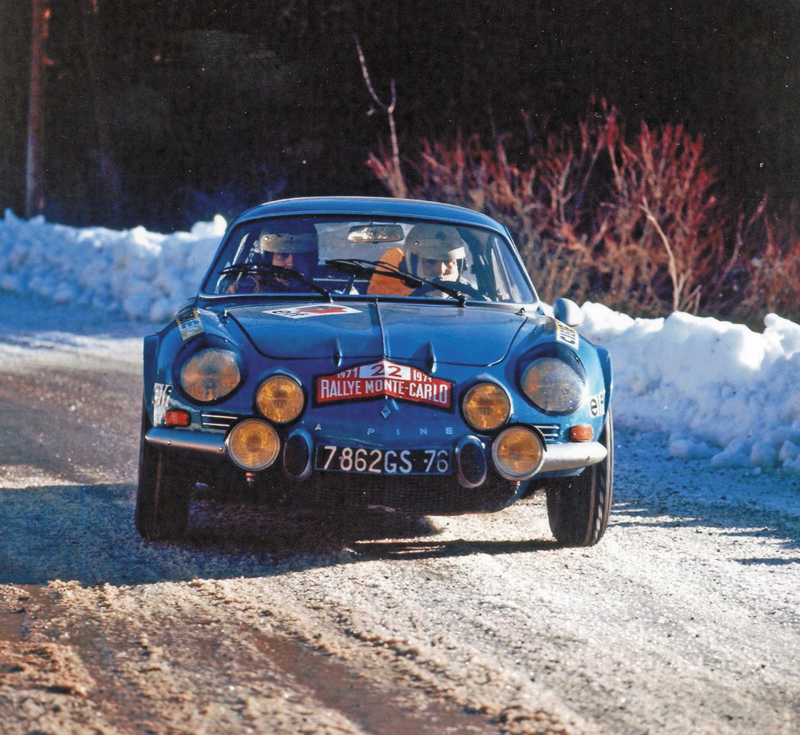
The Alpine A 110 1600S N° 22 of Jean-Claude Andruet and Michel Vial finished 3rd overall. © IXO Collections SAS - Tous droits réservés. Crédits photo © Renault D.R. / Archives et Collections
Since the 1970 season, the Monte Carlo Rally has been run as part of the International Championship for Manufacturers. International rallies were previously part of the European Manufacturer Championship and from 1973 onwards they were included in the World Rally Championship (WRC) as we know it today. The 1971 Championship consisted of 9 events and the Monte Carlo Rally was, as is tradition, the opening event. For its first success in this event, the Alpine factory team achieved a remarkable result by taking all three podium places and bringing five of its six competing cars to the finish.
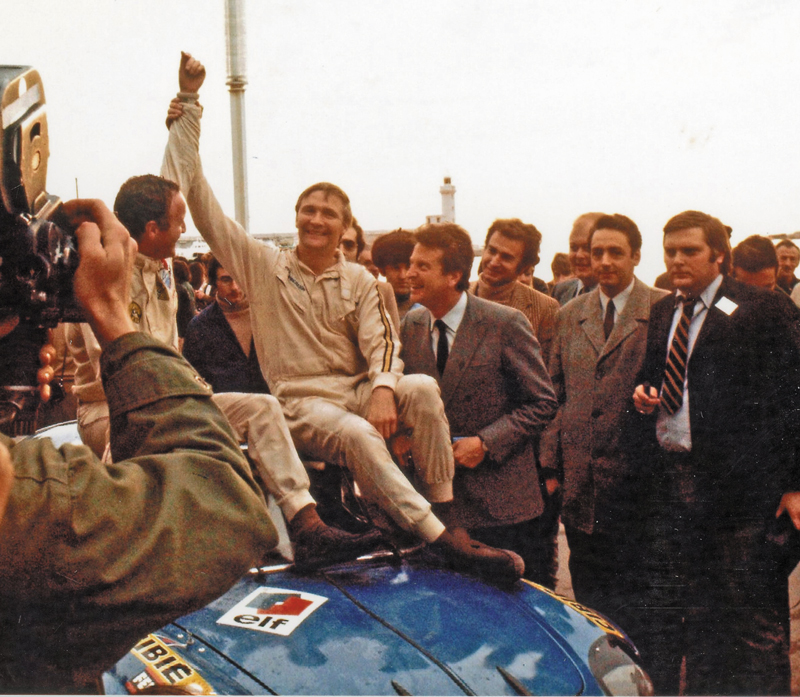
In 1971, Ove Anderson won his first major international rally in Monte Carlo. © IXO Collections SAS - Tous droits réservés. Crédits photo © Renault D.R. / Archives et Collections
A voluminous organisation
The 40th edition of the Monte Carlo Rally took place from 23 to 29 January 1971, with a preliminary concentration run and a 38 km special stage ending on 25 January. This was followed by a joint event on January 26 and 27 involving 20 stages over 1,516 km, including 9 special timed events over 252 km. A complementary event on the last two days is carried out over 11 stages with a total distance of 670 km including 7 special stages over 153 km. The entry list includes 248 competitors and the official Alpine-Renault team made a strong showing with six A 110 1600 S Berlinettes entered in Group IV (Class 1).
The Alpine factory team is supported by an extensive service department consisting of 8 Saviem trucks and a team of 25 mechanics. Each car has 240 tyres at its disposal to cope with all weather conditions and different types of surface. In addition to the drivers, there are "openers" who take part in each stage one hour before the start and who are responsible for scouting the route. All this organisation is orchestrated by Jacques Cheinisse, Alpine's Sporting Director and Jacques Féret, the head of Renault's competition department.
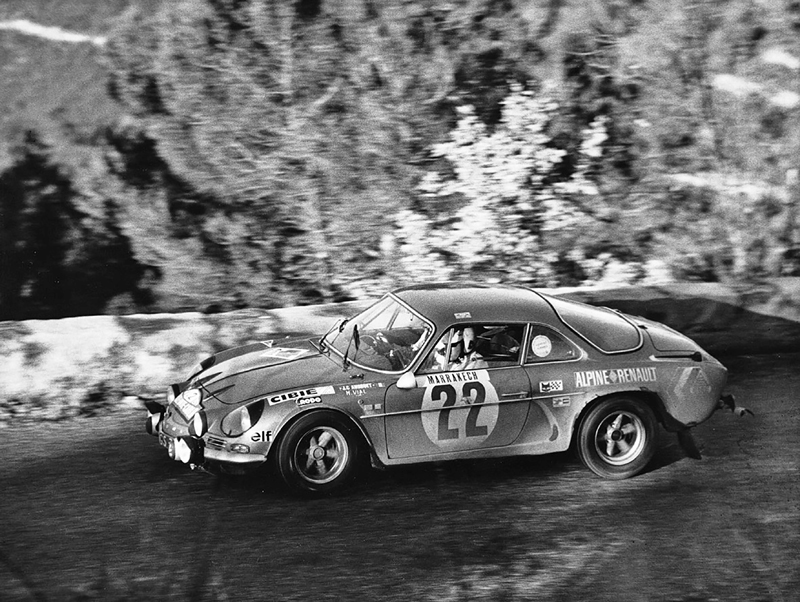
A rare event in rallying, Jean-Claude Andruet's Alpine and Björn Waldegaard's Porsche finished third together in 6h 32' 45". © IXO Collections SAS - Tous droits réservés. Crédits photo © Renault D.R. / Archives et Collections
An Armada of Berlinettes
For the concentration run, participants had a choice of ten different starting cities: Almeria, Athens, Bucharest, Frankfurt-Hanau, Glasgow, Marrakech, Monte Carlo, Oslo, Reims and Warsaw. The Alpine-Renault team chose to start from Marrakech because of the quality of the Spanish roads and the avoidance of snow-covered mountain ranges, which made it possible to preserve the cars and the tyre stock. The six Alpine crews were Jean-Pierre Nicolas-Claude Roure (No. 2), Jean Vinatier-Maurice Gelin (No. 5), Jean-Luc Thérier-Marcel Callewaert (No. 9), Bernard Darniche-Claude
Robertet (No. 12), Jean-Claude Andruet-Michel Vial (No. 22) and Ove Andersson-David Stone (No. 28). In addition to these factory Alpines, two other "semi-official" A 110s were entered by Bob Neyret (N° 18) and Jean-Marie Jacquemin (N° 36). There were also eight Berlinettes entered by private drivers, the best of which was the N° 65 of the Bulgarians Ilia and Kolu Tchoubrikov, finishing in a respectable 27th position overall.
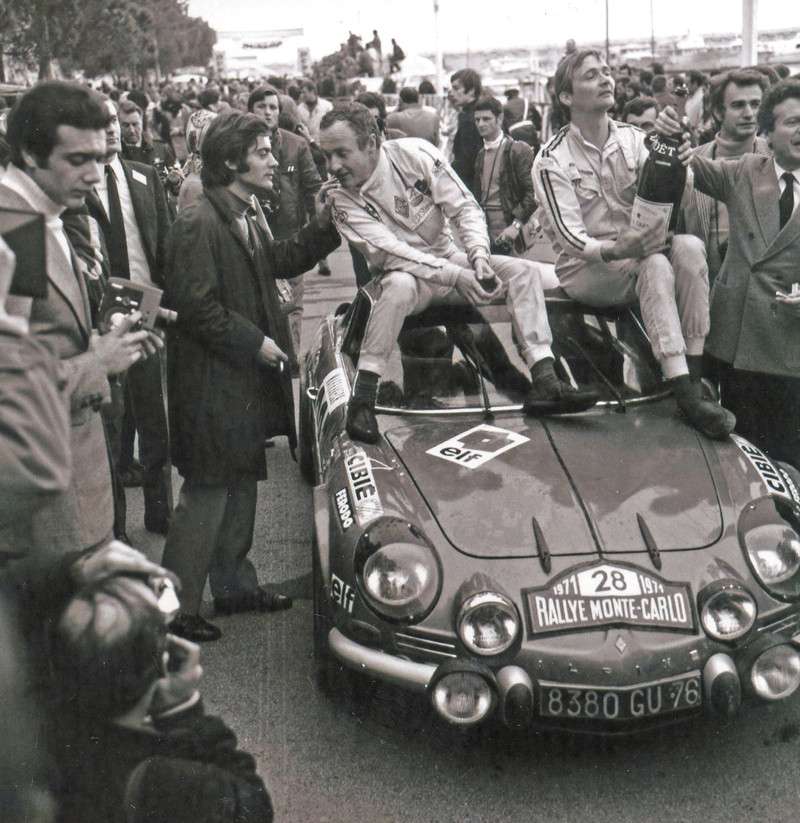
David Stone (left) and Ove Andersson celebrate their victory. © IXO Collections SAS - Tous droits réservés. Crédits photo © Renault D.R. / Archives et Collections
A clean slate for Alpine
From the first timed special stage, Ove Andersson took the lead in the general classification and only passed it twice to Thérier, in the fifth and sixth special stages. The Swede managed to win "only" five of the seventeen special stages, but his great regularity in the race ensured him victory. The official Porsche 911 S were not present, but the competition was no less fierce. The Porsche 914/6 of Valdegaard and the two Lancia Fulvia HF of Munari and Lampinen won three times each, while Andruet won twice for Alpine. Andersson won the 1971 Monte Carlo in 6h 30' 54", followed by Thérier at 40", then Andruet and Valdegaard in exactly the same time (unique in the annals of this rally) at 1' 51".
The No. 12 and No. 15 Alpines finished eighth and ninth, 10' 21" and 14' 12" behind the winning car, and the No. 2, who failed to finish the supplementary event, was 29th at 14' 13' 9". The impact of this Alpine hat-trick had a positive effect on the sales of the series production Berlinettes, because like the Le Mans 24 Hours, a success at the Monte Carlo Rally always generates commercial benefits for the winning brand. In this sense, Jean Rédélé, director of Alpine, carried out a successful communication campaign by having several identical replicas of the winning N° 28 car reproduced for display at car shows around the world.
For more information...
Jacques Cheinisse
Born in Normandy in 1934, Jacques Cheinisse is one of the main contributors to Alpine's reputation in international competition. After studying "elementary mathematics", he joined Alpine in 1963, working in the customer relations department while occasionally acting as a factory driver (Rally and Endurance). In 1968 he became team manager of Alpine and joined the company's board of directors, forcing him to put an end to his sporting career. Until the end of 1975 he enabled Alpine to win numerous titles in the European and World Championships, in Rally, Single Seater and Sport Prototypes. In 1976 he was appointed product manager at Renault and in 1984 director of the division. He left the company in 1997 to establish his own consultancy firm for the automotive industry.
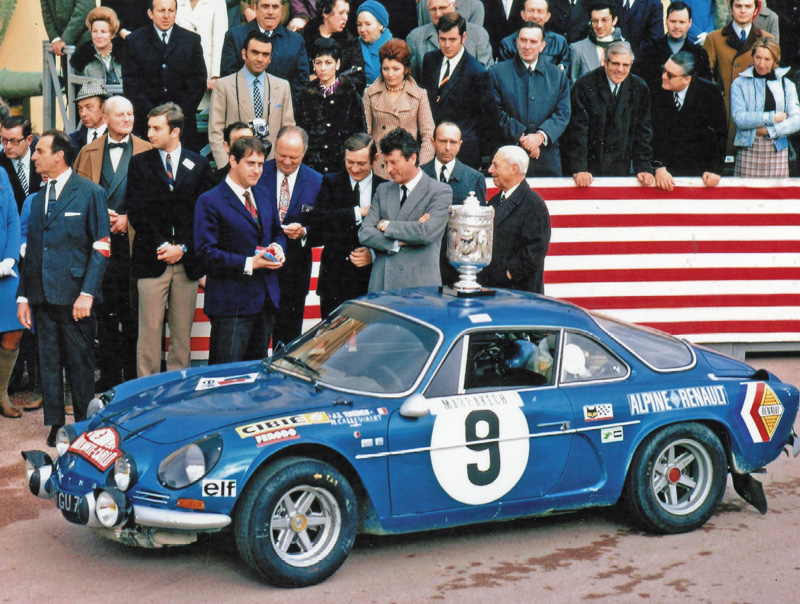
Marcel Callewaert and Jean-Luc Thérier are congratulated on their second position by Alpine boss Jean Rédélé (in grey suit). © IXO Collections SAS - Tous droits réservés. Crédits photo © Renault D.R. / Archives et Collections
The 1971 Championship
The 1971 International Championship of Manufacturers, organised by the FIA, was composed of 9 races. No official final classification was issued, but a summary table of victories was published. The Alpine A110 won the Monte Carlo, San Remo, Austria and Acropolis rallies thanks to Ove Anderson, as well as the Coupe des Alpes (Bernard Darniche), but the event was ultimately not included. The Saab 96 won in Sweden and the RAC Rally, the Datsun 240Z in the East African Safari and the Citroën SM in Morocco. In the manufacturers' rankings one finds Alpine (36 pts), Saab (18 pts) and Porsche (16.5 pts), Lancia (6 pts) and Datsun (11 pts). Among the drivers, Ove Anderson won 4 events, Stim Bloqvist (Saab): 2, Jean Deschazeaux (Citroën), Bernard Darniche (Alpine) and Edgar Herrmann (Datsun): 1.
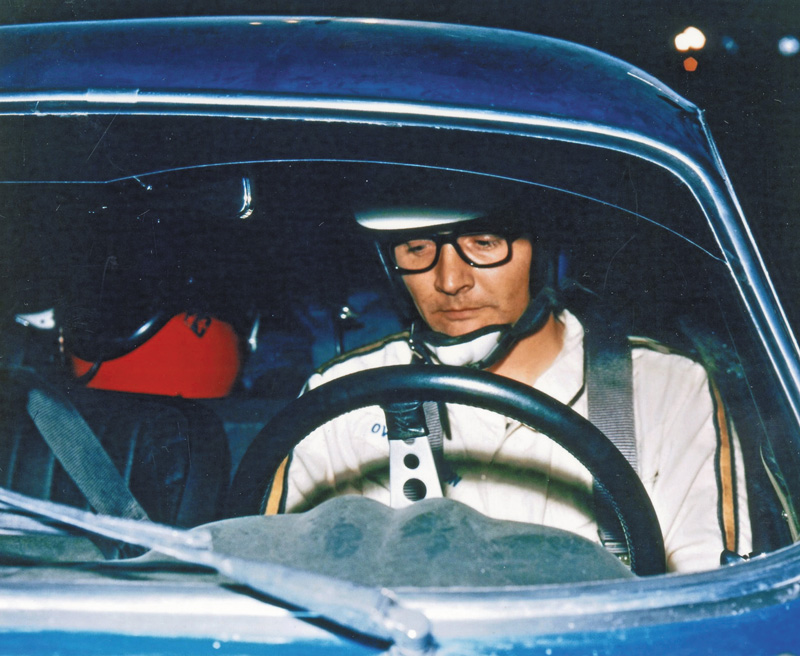
In 1971, following the Monte Carlo Rally, Swedish driver Ove Andersson won three more rallies in an Alpine. © IXO Collections SAS - Tous droits réservés. Crédits photo © Renault D.R. / Archives et Collections
The victorious Berlinette
The car that finished in the first three positions in the 1971 Monte Carlo Rally was the Alpine A110 1600 S Berlinette. This model, presented at the Geneva Motor Show in March 1967 and ending its official career in 1973, is considered to be the most consistent and best performing of the entire Alpine A 110 range. Its beam chassis, completed by a tubular frame, is covered by a polyester and fibreglass body. It is equipped with an in-line four-cylinder engine type R 807 of 1,596 cm3 (bore x stroke: 77.8 x 84 mm) from the Renault 16 TS series. The aluminium engine (block and cylinder head) produced 155 bhp at 7,000 rpm and a maximum torque of 17.2 mkg at 3,500 rpm, giving it a top speed of 225 km/h.
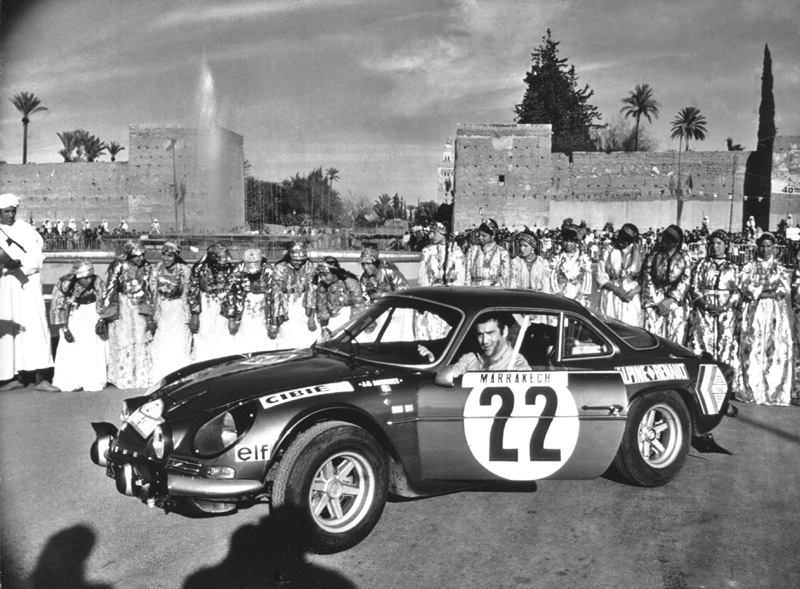
The factory Alpines ( with Jean-Claude Andruet here) choose Marrakech as starting point of the concentration run on 23 January at 0h00. © IXO Collections SAS - Tous droits réservés. Crédits photo © Renault D.R. / Archives et Collections
A legendary event
The Monte Carlo Rally, launched in 1911, is the main French event in the World Rally Championship. Similarly to the 24 Hours of Le Mans, a victory in the Monte Carlo Rally was the equivalent of a world title in terms of publicity and commercial benefits. In the post-war editions, the race itself, which consisted of some thirty special stages with time limits, was preceded by the famous "concentration run". The competitors had to reach Monaco from four different parts of Europe by following established routes on public roads. Those who made it to the end of this first demanding stage had to tackle the mountain roads overlooking the Principality of Monaco.
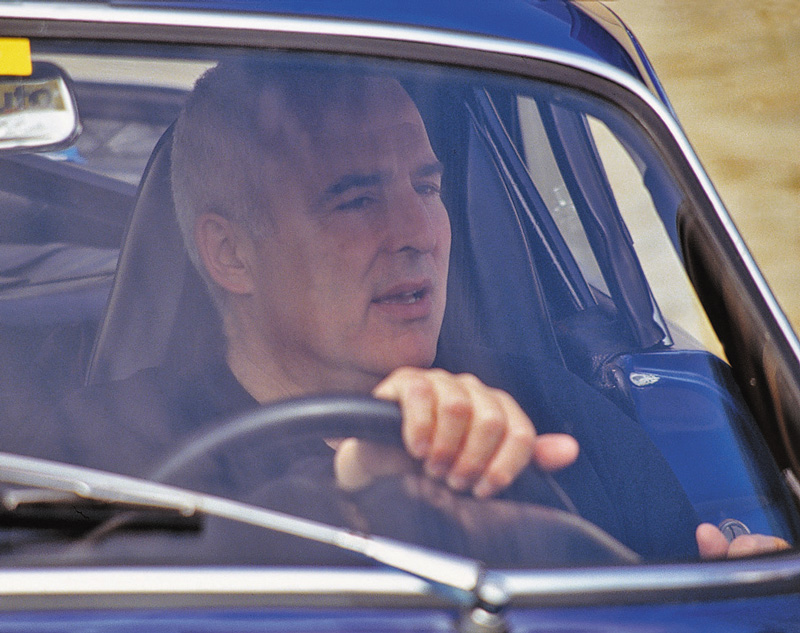
The Alpine A 110 1600S N° 22 of Jean-Claude Andruet and Michel Vial finished 3rd overall. © IXO Collections SAS - Tous droits réservés. Crédits photo © Renault D.R. / Archives et Collections
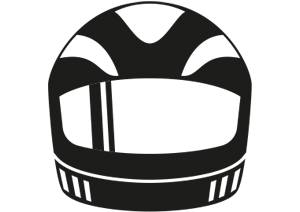
Ove Andersson
The 1971 Monte Carlo winner was a Swede, born on January 3, 1938 in Uppsala, who would prove to be one of the greatest Scandinavian rally drivers of the 1970s. He made an impression by finishing second in the 1967 Monte Carlo Rally with a Lancia and by winning the Spanish Rally that same year. In 1971, he won four rallies in an Alpine 1600 S: Monte Carlo, Acropole, San Remo and Austria and was one of the people behind Alpine's World Championship success in 1973. The following year he raced for Toyota and Peugeot (Safari Rally). In 1980, Andersson ended his racing career to pursue a career as sporting director of Toyota Team Europe, then in Endurance in 1997 and Formula 1 in 2002. Ove Andersson died on 11 June 2008 in Oudtshoorn, South Africa, where he lived.

General classification
1st : Ove Andersson - David Stone (Alpine A 110 1600 S)
2 nd : Jean-Luc Thérier - Marcel Callewaert (Alpine A 110 1600 S)
3rd : Jean-Claude Andruet - Michel Vial (Alpine A 110 1600 S)
3rd Ex-aequo : Björn Valdegaard - Mats Thorzselius (Porsche 914/6)
5th : Rauno Aaltonen - Paul Easter (Datsun 240 Z)
6th : Simo Lampinen - John Davenport (Lancia Fulvia 1600 HF)
7th : Häkan Lindberg - Solve Andreasson (Fiat 124 Spider)
8th : Bernard Darniche - Claude Robertet (Alpine A 110 1600 S)
9th : Jean Vinatier - Maurice Gelin (Alpine A 110 1600 S)
Articles récents
Share this post





 Français
Français Anglais
Anglais Allemand
Allemand Espagnol
Espagnol Italien
Italien Portugal
Portugal


